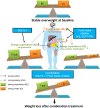Emerging Role of SGLT-2 Inhibitors for the Treatment of Obesity
- PMID: 30701480
- PMCID: PMC6394798
- DOI: 10.1007/s40265-019-1057-0
Emerging Role of SGLT-2 Inhibitors for the Treatment of Obesity
Abstract
Sodium-glucose co-transporter 2 (SGLT2) inhibitors are glucose-lowering drugs that reduce plasma glucose levels by inhibiting glucose and sodium reabsorption in the kidneys, thus resulting in glucosuria. Their effects consequently include reductions in HbA1c, blood glucose levels, and blood pressure, but also reductions in body weight and adiposity. The ability to reduce body weight is consistently observed in individuals taking SGLT2 inhibitors, but this weight loss is moderate due to counter-regulatory mechanisms striving to maintain body weight. This has prompted exploration of SGLT2 inhibitors in combination with other agents acting via decreased food intake, e.g., glucagon-like peptide 1 receptor agonists (GLP1-RAs). The bodyweight effects are promising, and together with the signs of prevention of cardiovascular and renal events, such combinations including SGLT2 inhibitors are appealing. The weight loss is clinically important, as most individuals with type 2 diabetes are overweight or obese, but also because there is an unmet need for safe, effective, and durable weight loss interventions in obese individuals without diabetes.
Conflict of interest statement
JWE has received research grants or honoraria from AstraZeneca, Bristol-Myers-Squibb, Merck Sharpe and Dohme, Bayer, Sanofi, and NovoNordisk. MJP has no conflicts of interest to declare.
Figures
References
-
- World Health Organization. Obesity and overweight fact sheet. 2017. http://www.who.int/mediacentre/factsheets/fs311/en/. Accessed 05 February 2018.
-
- Sirtori A, Brunani A, Capodaglio P, Berselli ME, Villa V, Ceriani F, et al. Patients with obesity-related comorbidities have higher disability compared with those without obesity-related comorbidities: results from a cross-sectional study. Int J Rehabil Res. 2016;39(1):63–69. doi: 10.1097/MRR.0000000000000146. - DOI - PubMed
Publication types
MeSH terms
Substances
LinkOut - more resources
Full Text Sources
Other Literature Sources
Medical


